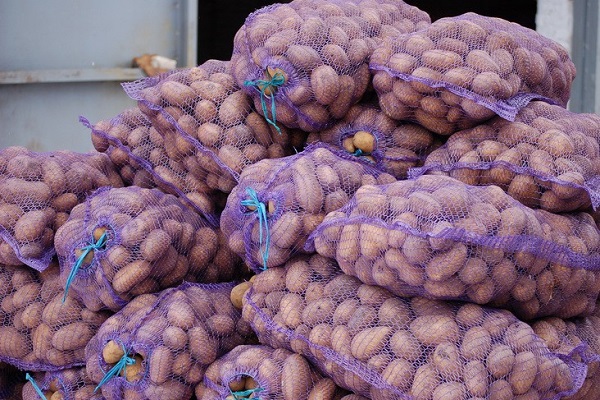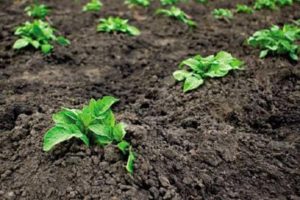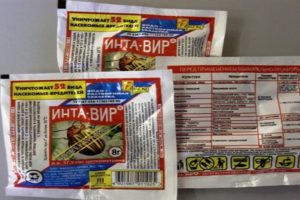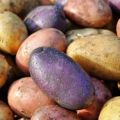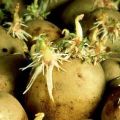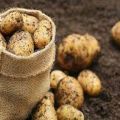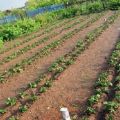Description of the Romano potato variety, features of cultivation and care
Romano potatoes were obtained by Dutch breeders in the 80s. The variety was delivered to the territory of our country in 1994. Carrying out test work, Russian scientists were so surprised by the qualities of this culture that they immediately included it in the State Register. What is such a respectability of the variety, how it is grown and what agricultural technology it needs, these and related questions will be answered in this article.
Description of the variety
According to research data, the Romano variety belongs to mid-season tuber crops. For its purpose, it is a versatile potato, which is used in the preparation of boiled and fried dishes, salads, pastries, casseroles. In addition, this variety produces high quality chips and fries.
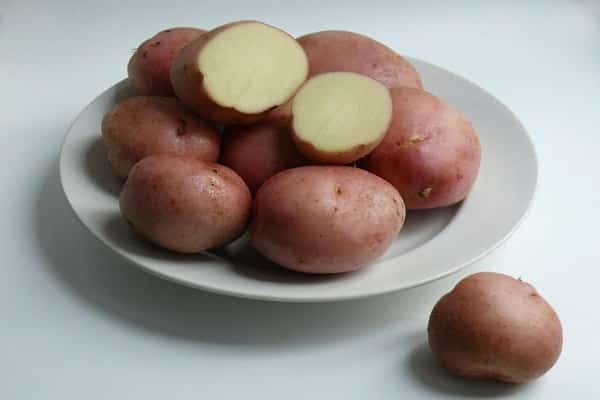
A distinctive feature of Romano from his fellows is that, regardless of weather conditions, he always gives a stable harvest. On average, gardeners can collect about 1 kg of tubers from one bush. From 100 acres, the yield is about 600 centners. At the same time, there are few unmarketable trifles or deformed potatoes.
General description of potatoes:
- bushes - medium height, maximum 50-60 cm;
- stems - erect, medium spreading;
- foliage - dark green, small;
- inflorescence - purple;
- the shape of the tubers is round;
- the skin is thin, smooth, light pink;
- eyes - superficial, finely visible;
- the pulp is milky;
- starch content - 15.5%;
- the average weight of one potato is 90-100 g.
If we evaluate the appearance and consumer qualities of potatoes on a 5-point scale, then the Romano variety deserves an honorable 5 points.

Growing
The Romano variety throughout the entire cultivation time in Russia has established itself as an undemanding crop. It can be grown in almost any area, regardless of the occurrence of groundwater, soil types and light conditions. However, every gardener wants to achieve the highest yield. In order for the plans to come true in life, the originators of the variety are advised to adhere to several growing rules.

Landing place
As practice has shown, grow potatoes better in southern or southwestern elevated places. The best option would be to plant the variety on the soil that could provide it with all the necessary nutrients and nutrients. If this is not possible, it is recommended to enrich the soil with complex fertilizers before planting.

Landing time
Planting time of Romano potatoes depends on the climatic conditions of the region.In central Russia, as a rule, tubers are planted in mid-May. In the northern regions, potatoes are planted in early June. In order not to be mistaken in the time for this manipulation, it is necessary to measure the temperature of the soil. The best option is considered when the soil at a depth of 10 cm warms up to + 9-13 degrees.
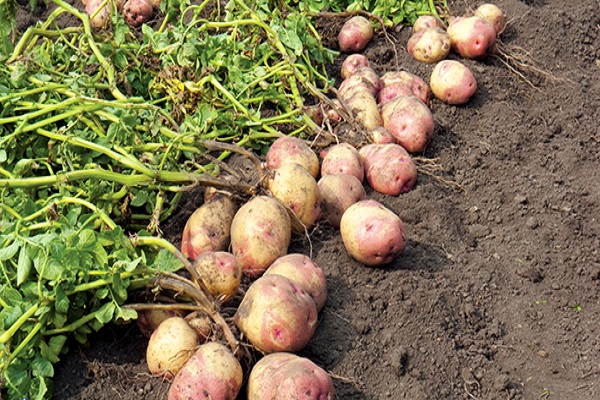
Preparation of planting material
Before planting potatoes, you must prepare them. To do this, 20-25 days before planting, experienced gardeners recommend the following manipulations:
- Remove the tubers from the cellar and sort them out from rot.
- Pour the prepared fruits with warm water, temperature 42-45 degrees.
- After the water has cooled to room temperature, add a weak solution of potassium permanganate to it.
- After 15 minutes, remove the tubers and treat with biofungicides.
Further, for the germination of sprouts, it is recommended to spread the potatoes in a bright, ventilated room.
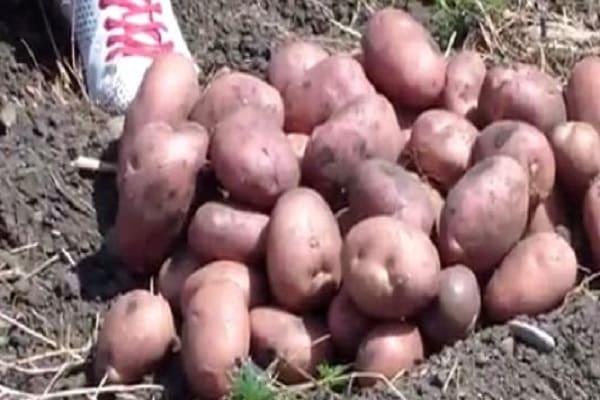
Landing scheme
To increase the amount of harvest and facilitate further potato care, it is very important to follow the landing pattern. The best option is considered when the distance between the holes is 40 cm and the distance between the rows is at least 70 cm.
The landing itself takes place in the following way:
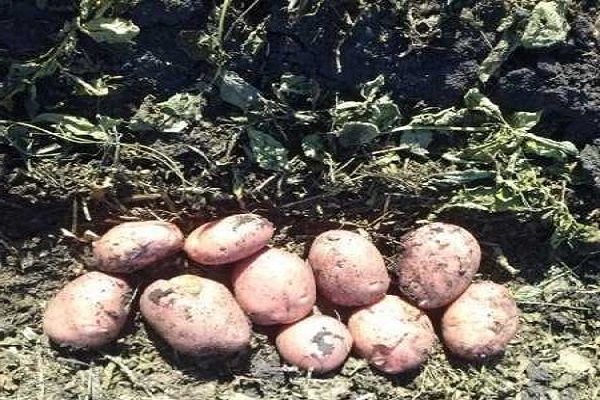
- Mineral fertilizers are first placed and dug into prepared holes 20 cm deep.
- Then the potatoes are laid down.
After sprinkling the tubers with soil, the plot is watered.
Tip: To prevent the first shoots of seedlings from freezing from spring frosts, it is recommended to bury them with a 5 cm layer of earth.If this is not done, the yield will still be, but much lower.

Care features
The Romano variety, like any other vegetable crop, needs agricultural technology. Timely care will ensure high quality fruit and increase yields.
So, let's consider the techniques of technology in the cultivation of potatoes:
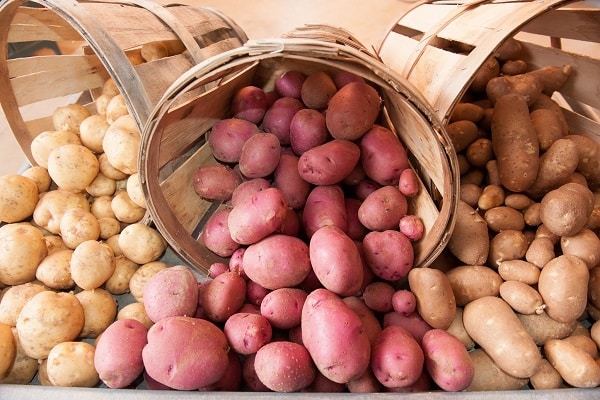
- Loosening the soil. Top-dressing the soil will help remove weeds and prevent crusting after rain.
- Watering. Irrigation of the plant is carried out only in cases when there is a drought for a long time.
- Top dressing. Complex fertilizers contribute to the rapid growth and development of potatoes. Top dressing is carried out after the emergence of sprouts, during the flowering of the tops and 2 weeks later, after budding.
- Hilling bushes. Rolling the loose soil onto the potato stalks will enrich the root system with oxygen and increase the space for tubers to grow.
- Plant processing. To avoid the development of potato diseases and to prevent the harmful effects of insects, it is recommended to spray with insecticides.
As you can see, agricultural technology is not so difficult, however, it is of great importance when growing the Romano variety.

Advantages and disadvantages
The characteristic of the Romano variety suggests that it is endowed with a large number of positive qualities. Among the main advantages of potatoes, gardeners distinguish:
- perfect taste;
- attractive appearance;
- long transportation;
- high immunity to certain diseases;
- drought tolerance;
- responsiveness to feeding;
- long keeping quality.
There were no significant shortcomings in the variety. However, when choosing it, it is worth considering that potatoes are not resistant to frost.
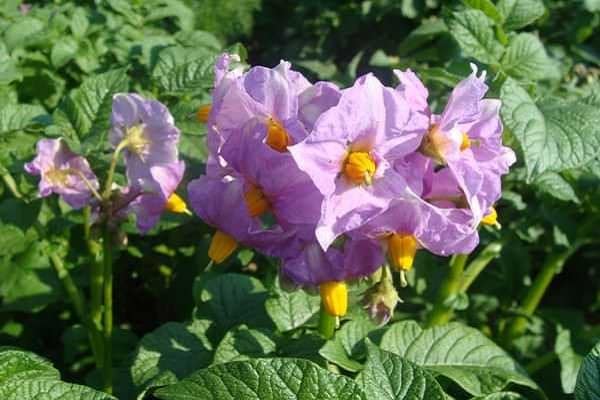
Pests and diseases
The Romano variety is famous for its good immunity to major potato diseases. He does not succumb to diseases such as:
- cancer;
- wet rot;
- chlorosis of leaves;
- rhizoctonia;
- wrinkled mosaic.
In addition, the tubers of the plant are resistant to late blight. But, despite such a high immunity, Romano is vulnerable to diseases such as common scab and nematode.

If we talk about insects, then the most dangerous for potatoes are:
- Colorado beetle;
- caterpillars of the scoop;
- leafhoppers.
Pests such as wireworm and potato flea are not dangerous for the Roman variety.

Harvesting and storage
The harvest of Romano potatoes is carried out in late August or early September. This period depends on the climatic conditions of the region.
Gardening tips for harvesting:
- In order for the tubers to be well ventilated and dry, the potatoes should be digged in clear weather.
- It is recommended to mow the tops and weeds 10 days before starting the harvest. In this case, the peel of the potato will get stronger and will not be damaged during transportation and storage.
- Dried harvested potato tubers should stand in bags for several days. Then they need to be sorted out and stored.

As a rule, winter storing potatoes carried out in an underground, cellar or basement. Practice has shown that tubers do not lose their taste and external qualities for a long time when the temperature inside the room is + 2–5 degrees, and the air humidity is 90%.
So, having considered the description of the variety, its characteristics and advantages, we can conclude that Romano is a rather promising culture. By planting this variety, you can be sure of a stable yield of delicious fruits.
